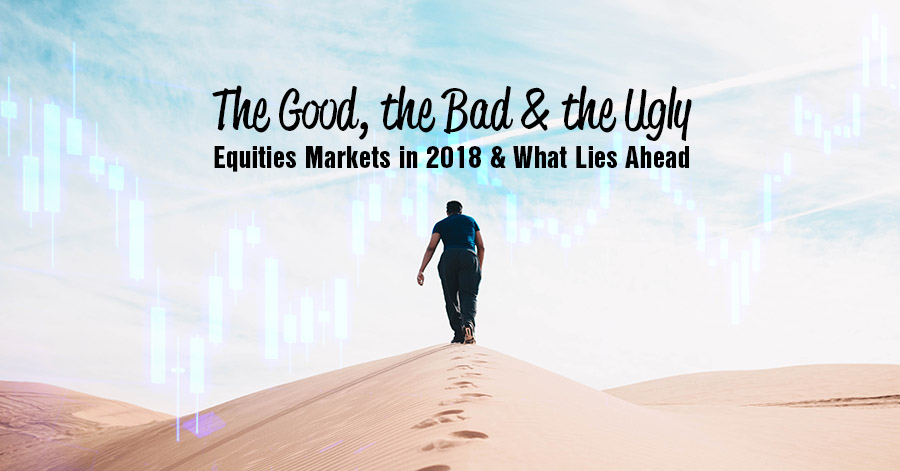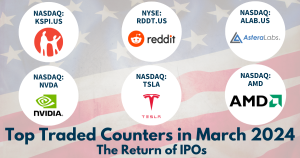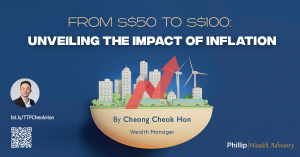The Good, the Bad & the Ugly: Equities Markets in 2018 & What Lies Ahead January 30, 2019

It was a roller coaster ride for investors globally in 2018 as many market indices gave up their gains during the first half of the year. Volatility seen in the stock market arose as the trade war between the US and China, geopolitical tensions and growth concerns about the FAANG (Facebook, Apple, Amazon, Netflix and Alphabet’s Google) tech stocks took hold. These have instilled panic amongst investors, with stock markets shedding billions of dollars in market capitalisation. As investors start a brand new investing chapter in 2019, let us review and see what the best and worst performing stock market indices were in 2018.
Table of Global Stock Market Indices that are tradable with POEMS:
| No. | Index Name | Last Close in 2018 | 1YR Total Return (%) | P/E (x) | Div Yield (%) | 5YR Total Return (%) |
| 1 | Jakarta Stock Exchange Composite | 6,194.50 | – 0.28 | 16.53 | 2.16 | 9.91 |
| 2 | Australia S&P/ASX 200 | 5,646.80 | – 1.47 | 14.35 | 5.14 | 7.18 |
| 3 | NASDAQ Composite Index | 6,635.28 | – 2.81 | 19.76 | 1.34 | 11.06 |
| 4 | FTSE Bursa Malaysia KLCI Index | 1,690.58 | – 2.99 | 16.62 | 3.28 | 1.16 |
| 5 | Dow Jones Industrial Average | 23,327.46 | – 3.48 | 14.67 | 2.46 | 9.69 |
| 6 | US S&P 500 Index | 2,506.85 | – 4.39 | 15.43 | 2.18 | 8.48 |
| 7 | Taiwan Stock Exchange Weighted | 9,727.41 | – 4.95 | 12.66 | 4.74 | 6.31 |
| 8 | Singapore Straits Times Index | 3,068.76 | – 6.47 | 12.57 | 4.23 | 2.84 |
| 9 | Vietnam Ho Chi Minh Stock Index | 892.54 | – 7.53 | 15.78 | 1.77 | 15.67 |
| 10 | Stock Exchange of Thailand Index | 1,563.88 | – 8.09 | 14.60 | 3.29 | 7.14 |
| 11 | FTSE 100 Index (LSE) | 6,728.13 | – 8.78 | 11.93 | 5.12 | 3.86 |
| 12 | S&P/TSX Composite Index (Canada) | 14,322.86 | – 8.88 | 13.60 | 3.45 | 4.05 |
| 13 | Japan Nikkei 225 | 20,014.77 | – 10.39 | 14.52 | 2.28 | 6.13 |
| 14 | Hong Kong Hang Seng Index | 25,845.70 | – 10.55 | 10.82 | 3.87 | 5.92 |
| 15 | Philippines Stock Exchange Index | 7,480.41 | – 10.80 | 15.66 | 1.78 | 6.76 |
| 16 | EURO STOXX 50 Index | 3,001.42 | – 11.34 | 12.70 | 4.09 | 2.85 |
| 17 | Korea Stock Exchange KOSPI Index | 2,041.04 | – 16.78 | 8.68 | 2.26 | 1.74 |
| 18 | Borsa Istanbul 100 Index (Turkey) | 91,270.48 | – 17.61 | 6.71 | 4.49 | 9.47 |
| 19 | Deutsche Boerse AG German Stock | 10,558.96 | – 18.26 | 12.15 | 3.63 | 2.03 |
| 20 | Shanghai Stock Exchange Composite | 2,493.90 | – 22.74 | 10.28 | 3.10 | 5.72 |
| 21 | Shenzhen Stock Exchange Composite | 1,267.87 | – 32.51 | 14.64 | NA | 4.58 |
| Average | – 10.05 | 13.56 | 3.23 | 6.31 |
(Source : Bloomberg)
The table above shows a list of Global Stock Market Indices that are tradable through POEMS, sorted by 1-Year total return (TR), where total return includes capital gain as well as dividends received and reinvested. All indices compiled for this article recorded a negative 1-Year TR for the year 2018, with an average total return of -10.05%, forward price/earnings (P/E) of 13.56x and dividend yield of 3.23%.
From the list of countries’ exchanges that our customers can trade, Indonesia performed the best based on 1-year total return, with the Jakarta Composite Index recording a total return of -0.28%. On the other hand, China performed the worst, with the Shanghai and Shenzhen Composite Index recording returns of -22.7% and -32.5% respectively. While investing in stock markets appears to be clouded by doom and gloom in 2018, it would be short-sighted to gauge a market’s outlook just by looking at its performance over a year. As investing maestro Warren Buffett once said:
“If you aren’t willing to own a stock for ten years, don’t even think about owning it for ten minutes. Put together a portfolio of companies whose aggregate earnings march upward over the years, and so also will the portfolio’s market value.”
With all that said, let’s do a recap of how some markets fared in 2018!
Indonesia: Jakarta Stock Exchange Composite (1st position)
The total return for the Jakarta Stock Exchange Composite Index in 2018 was -0.28% with a 5-year annualised TR of 9.9%. It has a lower dividend yield of 2.16% compared to the indices average of 3.23%. As an emerging market, Indonesia is affected by US monetary policy, tightening of global financing conditions as well as volatile exchange rate movements.1
Indonesia will hold its General Elections this year on 17 April with President Joko Widodo, also known as Jokowi running for re-election.2 Any unexpected election result will create market volatility for the Jakarta Stock Exchange.
Putting aside political uncertainty, what are the investment merits that could propel the Indonesia Index upwards? According to a Mckinsey report, Indonesia is expected to account for 40% of ASEAN’s growth by 2030.3 The key drivers include a young population and rapid population growth. With continuous urbanization plans, there has been an increase in consumer spending. The same Mckinsey report highlighted that Indonesians strongly prefer and trust local brands as they believe that local companies provide better value for money, compared to foreign brands.
For investors who wish to gain exposure to the Indonesia market, below is a list of big-cap Indonesia stocks that are considered market leaders in their respective business segments.
| Ticker | Short Name | GICS SubInd Name | Market Cap (USD Bil) | Last Px (IDR) | Buy | Hold | Sell | Consensus Target Px (IDR) |
| ASII IJ | ASTRA INTERNATIONAL | Automobile Manufacturers | 22.9 | 8,200 | 26 | 6 | 1 | 9,134 |
| BBRI IJ | BANK RAKYAT INDO | Diversified Banks | 30.7 | 3,610 | 28 | 7 | 1 | 3,897 |
| GGRM IJ | GUDANG GARAM TBK | Tobacco | 11.1 | 82,200 | 26 | 2 | 2 | 90,968 |
| BMRI IJ | BANK MANDIRI | Diversified Banks | 23.5 | 7,225 | 26 | 8 | 0 | 8,301 |
| TLKM IJ | TELEKOMUNIKASI | Integrated Telecommunication Services | 25.5 | 3,720 | 30 | 6 | 0 | 4,314 |
(Source : Bloomberg)
For investors looking for a diversified option, they may look at Exchange Traded Funds (ETFs) such as iShares MSCI Indonesia ETF (EIDO.US), which is listed in the US market. It has an asset under management (AUM) size of around US$527 million and expense ratio of 0.62%. The above 5 stocks are included among the top 10 holdings in the iShares MSCI Indonesia ETF.
Australia: ASX 200 Index (2nd position)
While the ASX 200 Index total return declined close to 1.5% in 2018, it boasts the highest dividend yield in the list at 5.14%, largely due to Australian banking shares. The four largest banks in Australia are in the top 10 in terms of dividend yield by market cap – each contributing gross dividend yields of at least 8%.
In terms of valuation, three are currently trading below the ASX200 Index’s P/E and price-to-book (P/B). With healthy fundamentals, attractive relative valuations and a consistent history of dividends, Australian banking shares are an investment worth considering.
| Ticker | Name | Market Cap (AUD Bil) | Gross Div Yield | P/E | P/B |
| CBA AU Equity | COMMONWEALTH BANK OF AUSTRALIA | 125.7 | 8.56 | 13.4 | 1.9 |
| WBC AU Equity | WESTPAC BANKING CORP | 85.4 | 10.73 | 10.5 | 1.3 |
| ANZ AU Equity | AUST AND NZ BANKING GROUP | 69.1 | 9.43 | 9.88 | 1.2 |
| NAB AU Equity | NATIONAL AUSTRALIA BANK LTD | 65.9 | 11.8 | 11.1 | 1.3 |
(Source : Bloomberg)
United States: NASDAQ, Dow Jones and S&P 500 (3rd, 5th and 6th position)
As three of the most followed indices by investors around the world, many have seen the ups and downs of the NASDAQ, Dow Jones and S&P 500 throughout 2018 – which depict a snapshot of the US market as a whole. The US Federal Reserve raised interest rates a total of four times during 2018, with the rate coming between the 2.25%-2.5% range at the end of the year – a range last seen in March 2008 just before Lehman Brothers failed, sparking the global financial crisis.4 The FAANG stocks, which make up a significant portion of the indices, underperformed in 2018 as they fell from all-time record highs registered in 2018.
For 2019, investors should continue to watch out for the US Fed’s position on interest rates and FAANG stocks. Things are on track for a slowdown in the pace of interest rate hikes in 2019, with two hikes expected across the 4 key Fed meetings in 2019. Tech counters are expected to remain volatile due to factors like weaker demand for certain FAANG products (resulting in the slashing of forecasts), as well as greater scrutiny from lawmakers. But with technology a key part of our daily lives, continued reliance on FAANG products is unlikely to go away, with the tech stocks still finding their place in an investor’s portfolio. For investors who shy away from exposure to single stocks, other options are ETFs such as PowerShares QQQ (Ticker: QQQ US), Technology Select Sector SPDR Fund (Ticker: XLK US), or Vanguard Information Technology ETF (Ticker: VGT US). These ETFs have a place alongside the likes of Apple, Amazon, Facebook, Alphabet and Microsoft amongst the top holdings.
In addition, with ongoing geopolitical tensions and trade disputes, investors may look at safe haven investments such as the US dollar and Gold. The Invesco DB US Dollar Index Bullish Fund (Ticker: UUP US) offers investors exposure to the dollar against a broad range of developed market currencies. For commodities such as Gold, investors may consider SPDR Gold Trust (Ticker: GLD US) – the largest ETF to invest directly in physical gold.
A summary of the ETFs:
| ETF Name | Ticker/ Exchange | Fund Strategy | Inception Date | Traded Currency | Market Cap (in billions) | Expense Ratio | Total Holdings in ETF |
| Invesco QQQ Trust Series 1 | QQQ US | Growth | 10/3/1999 | USD | USD 60.62 | 0.20% | 103 |
| Technology Select Sector SPDR | XLK US | Growth | 22/12/1998 | USD | USD 17.30 | 0.13% | 69 |
| Vanguard Information Technology | VGT US | Growth | 30/1/2004 | USD | USD 17.18 | 0.10% | 338 |
| Invesco DB US Dollar Index Bull | UUP US | Currency | 20/2/2007 | USD | USD 0.49 | 0.80% | 7 |
| SPDR Gold Shares | GLD US | Precious Metals | 18/11/2004 | USD | USD 32.96 | 0.40% | NA |
(Source : Bloomberg)
Here are more trading ideas for the US market:
– Identifying Potential Opportunities in 2 US Sectors for 2019
– 2019 US Banking Sector Outlook – Market too pessimistic
Vietnam: Ho Chi Minh Stock Index (9th position)
The Ho Chi Minh Stock Index finished 2018 in 9th position, with total return standing at -7.53%. Interestingly, before the last week of 2018, Vietnam was at the top of the list before a dramatic drop towards the last few trading days of the year. Despite this drastic turn, the index still tops the list with regard to the 5-year annualised total return, coming in with a commendable 15.67%. According to a Business Times article, Vietnam’s economy is expected to grow by 6.8% in 2018, with a target growth of around 6.6%-6.8% in 2019.5 Population demographics, low labour costs and a growing middle class were 3 key drivers covered in our Vietnam Market Journal that will help sustain the country’s GDP growth
As one of the most vibrant emerging markets around, Vietnam is expected to meet its growth target in 2019. In fact, Vietnam is part of the N-11, a set of countries with large populations that could have a meaningful impact on the global economy.6 Alongside Vietnam, other countries include Indonesia, South Korea, the Philippines, Bangladesh, Pakistan and Turkey. Large and young populations in these countries will drive growth in consumer spending. Investors may therefore want to keep an eye on the progress of the Vietnam economy and include the Vietnam market on their investment watch list.
For investors that do not want to take on the risks of single stock exposures, other options are ETFs that hold a basket of Vietnamese Stocks like the VFMVN30 ETF FUND (Ticker: E1VFN30 VN) which is listed on the Ho Chi Minh Stock Exchange, or the VanEck Vectors Vietnam ETF (Ticker: VNM US) listed in the US.
A summary of the ETFs:
| ETF Name | Ticker/ Exchange | Geography | Inception Date | Traded Currency | Market Cap (in billions) | Expense Ratio | total Holdings in ETF |
| VFMVN30 ETF Fund | E1VFVN30 VN | Vietnam | 14/8/2014 | VND | VND 4,165 | 0.80% | 30 |
| VanEck Vectors Vietnam ETF | VNM US | Vietnam | 14/8/2009 | USD | USD 0.32 | 0.66% | 26 |
(Source : Bloomberg)
Japan: Nikkei 225 Index (13th position)
The Tokyo Stock Exchange, another heavyweight, is the fourth biggest exchange in the world. With more than 3,500 listed companies, the Exchange is home to large and well-known global giants. It suffered the same fate as its peers in 2018, with the Japan Nikkei 225 down 10.39% at the end of the year.
After 20 years of stagnation, Japan’s economy is gradually making a comeback. With the upcoming 2020 Olympics that will be held in Tokyo, the opportunity has arisen to boost the country’s economy. However, the degree to which that can happen may be limited due to the increase in sales tax from 8% to 10% to help alleviate national debt and pay for healthcare costs. With higher taxes, consumer spending may be impacted and this in turn may affect Japan’s economic growth.
Some popular ETFs that investors can invest in to gain exposure to Japanese equities are the Nikkei 225 Exchange Traded Fund (1321.JP) and TOPIX Exchange Traded Fund (1306.JP). These ETFs include iconic Japanese companies such as Softbank Group (9984.JP), Toyota Motor (7203.JP) and Fast Retailing (9983.JP) among their top holdings.
A summary of the ETFs:
| ETF Name | Ticker/ Exchange | Geography | Inception Date | Traded Currency | Market Cap (in billions) | Expense Ratio | Total Holdings in ETF |
| Nikkei 225 Exchange Traded Fund | 1321 JP | Japan | 9/7/2001 | JPY | JPY 5,504 | 0.22% | 226 |
| TOPIX Exchange Traded Fund | 1306 JP | Japan | 13/7/2001 | JPY | JPY 7,936 | 0.11% | 2,110 |
(Source : Bloomberg)
Find out more about the Japan market in our Market Journal: 5 of the Biggest Market Cap Japanese Counters Investors Should Know About
China Shanghai and Shenzhen Composite Index (20th & 21st position)
It may be one of the largest emerging market economies, but analysts have forecast that China will register a GDP growth of less than 6.5% for 2019.8 Adding to the uncertain outlook for the China market – ongoing trade tensions with the US, as Chinese President Xi Jinping and American President Donald Trump search for a middle ground to resolve the dispute.
On a positive note, after the initial inclusion of China A shares into MSCI Indexes, the MSCI is looking to increase its weightage to 20% in 2019.7 This signals a positive view to the once tightly-controlled economy which may encourage international investors to start allocating their funds into the China market. Investors can use ETFs like the iShares China Large-Cap ETF (FXI.US) listed in the US or iShares FTSE A50 China ETF (2823.HK) listed in Hong Kong to gain exposure to China blue chip stocks like Ping An Insurance, China Construction Bank, China Mobile, and so on.
A summary of the ETFs:
| ETF Name | Ticker/ Exchange | Geography | Inception Date | Traded Currency | Market Cap (in billions) | Expense Ratio | Total Holdings in ETF |
| iShares FTSE A50 China Index ETF | 2823 HK | China | 15/11/2004 | HKD | HKD 24.08 | 0.99% | 50 |
| iShares China Large-Cap ETF | FXI US | China | 8/10/2004 | USD | USD 5.66 | 0.73% | 58 |
(Source : Bloomberg)
Taking into account that the events of 2018 are spilling into the New Year, market volatility seems to be a theme that will continue to surface in 2019. With Democrats taking over the US House of Representatives looking to clash with President Trump, the flash crash of currencies and ongoing geopolitical tensions, investors should stay on their feet for the latest market developments, and look to maximize gains and minimize losses within their securities portfolios.
Keep yourself updated through our various investor education materials:
StocksBnB: Phillip Securities’ Research Wing
POEMS Market Journal: Stay updated with insights from our specialists!
Events & Seminars: Learn best practices and hear about the latest market outlook from experts and special guests
Information is accurate as of 4 Jan 2019
Reference:
- [1] Phillip Indonesia Research
- [2] SCMP, Indonesia’s election battle takes shape, 10 August, 2018
- [3] Mckinsey&Company, The evolving Indonesia consumer, January 2014
- [4] The balance, Fed Funds Rate History with Its Highs, Lows and Chart, 19 December 2018
- [5] The Business Times, Vietnam – The coming of age of a vibrant Tiger Cub Economy, 20 December 2018
- [6] Goldman Sachs, N11 Equity Portfolio, 20th February 2013
- [7] MSCI, Consultation on further weight increase of China A shares in the MSCI Indexes, December 2018
- [8] Bloomberg
Disclaimer
These commentaries are intended for general circulation. It does not have regard to the specific investment objectives, financial situation and particular needs of any person who may receive this document. Accordingly, no warranty whatsoever is given and no liability whatsoever is accepted for any loss arising whether directly or indirectly as a result of any person acting based on this information. Opinions expressed in these commentaries are subject to change without notice. Investments are subject to investment risks including the possible loss of the principal amount invested. The value of the units and the income from them may fall as well as rise. Past performance figures as well as any projection or forecast used in these commentaries are not necessarily indicative of future or likely performance. Phillip Securities Pte Ltd (PSPL), its directors, connected persons or employees may from time to time have an interest in the financial instruments mentioned in these commentaries. Investors may wish to seek advice from a financial adviser before investing. In the event that investors choose not to seek advice from a financial adviser, they should consider whether the investment is suitable for them.
The information contained in these commentaries has been obtained from public sources which PSPL has no reason to believe are unreliable and any analysis, forecasts, projections, expectations and opinions (collectively the “Research”) contained in these commentaries are based on such information and are expressions of belief only. PSPL has not verified this information and no representation or warranty, express or implied, is made that such information or Research is accurate, complete or verified or should be relied upon as such. Any such information or Research contained in these commentaries are subject to change, and PSPL shall not have any responsibility to maintain the information or Research made available or to supply any corrections, updates or releases in connection therewith. In no event will PSPL be liable for any special, indirect, incidental or consequential damages which may be incurred from the use of the information or Research made available, even if it has been advised of the possibility of such damages. The companies and their employees mentioned in these commentaries cannot be held liable for any errors, inaccuracies and/or omissions howsoever caused. Any opinion or advice herein is made on a general basis and is subject to change without notice. The information provided in these commentaries may contain optimistic statements regarding future events or future financial performance of countries, markets or companies. You must make your own financial assessment of the relevance, accuracy and adequacy of the information provided in these commentaries.
Views and any strategies described in these commentaries may not be suitable for all investors. Opinions expressed herein may differ from the opinions expressed by other units of PSPL or its connected persons and associates. Any reference to or discussion of investment products or commodities in these commentaries is purely for illustrative purposes only and must not be construed as a recommendation, an offer or solicitation for the subscription, purchase or sale of the investment products or commodities mentioned.
About the author
Global Markets Team
Phillip Global Markets offers you access to more than 23 global stock exchanges with just a single account. We are the epitome of workaholics – watching international exchanges round the clock and going to sleep only when the market stops trading. Our team of dedicated day and night dealers keep a keen eye on the latest developments impacting the world of stocks and shares.

 Back in Business: The Return of IPOs & Top Traded Counters in March 2024
Back in Business: The Return of IPOs & Top Traded Counters in March 2024  From $50 to $100: Unveiling the Impact of Inflation
From $50 to $100: Unveiling the Impact of Inflation  How to soar higher with Positive Carry!
How to soar higher with Positive Carry!  Why 2024 Offers A Small Window of Opportunity and How to Position Yourself to Capture It
Why 2024 Offers A Small Window of Opportunity and How to Position Yourself to Capture It 















